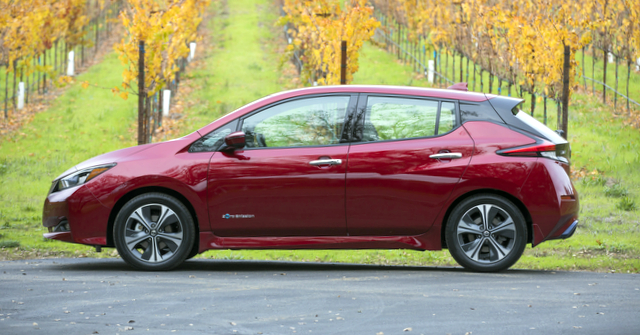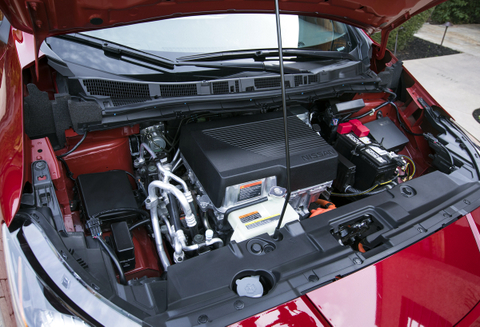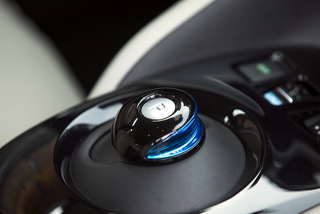Restart for the EV Volume Leader
The Nissan Leaf, introduced in 2010 as a 2011 model, is the world’s most popular mass-production electric car. But, with an expanding EV market, it was time for an upgrade.
While the original car was a study in soft curves, the 2018 Nissan Leaf is edgier, and looks more like a regular car, with a traditional face on the outside and a more upright and structured dash panel inside. The body shape remains a four-door hatchback with room for five and generous cargo space.

While the similarly sized and shaped Chevrolet Bolt EV gets 238 miles of range from its 60-kWh lithium-ion battery, the Leaf pulls just 150 from its 40-kWh one. Nissan says a 60-kWh, 200+ mile-range battery is coming, but my Deep Blue Pearl test car had the 40.
The Mid-Range Conundrum
Why would Nissan introduce a brand-new Leaf with significantly less range than the Bolt EV, its most direct competitor? One reason is that 150 miles is a lot more than the previous model’s 107 (from a 30-kW battery), and it may be enough for most uses.
The other reason is price. While the lower-level Bolt LT stickers at $36,620, the base S model Leaf starts at just $29,990. The mid-level SV begins at $32,490, while the upper-level Leaf SL, with leather seating (blended smooth hide and suede), power adjustment (unavailable in any Bolt) and more, lists at $36,200—nearly identical to the base Bolt. My SL tester came to $38,115, including a few options and an $885 destination charge. For comparison, a fully configured Bolt EV runs just under $44,000.

The 2018 Nissan Leaf’s 110-kW AC synchronous electric motor is good for 147 horsepower (hp) and a potent 236 pounds-feet (lb.-ft.) of torque. You can really feel it as you zoom ahead in normal driving; the Eco setting makes acceleration more lethargic, but still adequate, moving the 3,508-pound car down the road competently. For comparison, the Bolt EV is more powerful, with a 150 kW, 200-hp motor, with 266 lb.-ft. of torque.
Tech Features
The 2018 Nissan Leaf offers e-Pedal, which lets you use your right foot to press on the accelerator to move forward and ease up on the pedal to slow down—even to a stop. This is possible with electric motors, not gas engines. The e-Pedal works almost exactly like L (Low) in the Bolt, but once you set it, it stays on until you turn it off, while the Bolt defaults to normal D (Drive) and needs an extra flick of the lever to engage.

Nissan offers ProPILOT Assist Technology on the Leaf, meant to reduce driver fatigue. While it’s not autonomous driving—you must keep your hands on the wheel—you can set a following distance from the car in front while steering assist keeps you in the center of the lane automatically. It’s is a toe in the water of autonomy.
The Leaf’s electric port remains in its nose. You need to pop it open using a button on the dash, unlike the Bolt’s left-fender-mounted door. In there, two sockets sit side by side, since the Leaf uses the J1772 connector for Level 1 and 2 charging and the big round CHAdeMo socket for quick charging.
You can add up to 111 miles to the battery charge in five hours on Level 2 (240-volt) charging. Home charging on 120-volt household current is much slower, but you can add around 50 miles of range overnight. At public quick-charge stations you can add 90 miles in 30 minutes, so a 45-minute lunch stop should get you on your way.
My Commute
I like the Bolt’s 238 miles, but for my 18 miles each way of commuting, and running around the San Francisco Bay Area on weekends, 150 miles is actually plenty. The official EPA stats are 125 MPGe city/100 highway/112 combined. Compare these numbers to other battery-electric vehicles. Naturally, the Smog and Greenhouse gas numbers are perfect 10s.

Time in the Leaf is very pleasant, with supportive bucket seats and padded door panels that feel more luxurious than the more utilitarian Bolt. The screen in the center of the dash is much smaller then the generous 10.2-inch one in the Bolt. Climate controls sit in a low-mounted but easy to decipher bow tie. The steering wheel is adjustable for height but does not telescope. The little, round, blue-illuminated shift knob remains and is easier to use than the Bolt’s.
The new 2018 Nissan Leaf is much improved, both for its increased range and its style. But looking carefully, I realized that much of it is actually carried over. The distinctive windshield pillars remain, as do the front doors—inside and outside—and the interior and exterior door handles! With the changes, though, the car looks current and matches better with its fellow Nissans in the showroom.
(Ed note: And there’s more Leaf news coming—check it out here. The Leaf also has had a rough patch with battery issues in some recent models.
(Ed note2: One of our other regular contributors, Gary Lieber, did a head-to-head test of the 2018 Bolt and Leaf here.)
Lead photo by Lex Adams
Make sure to opt-in to the Clean Fleet Report newsletter (top right of page) to be notified of all new stories.
Related Stories You Might Enjoy—The Latest EV Competition
LA Auto Show: 2020 Kia Soul EV Debuts
LA Auto Show: 2019 Kia Niro EV Introduced
News: Entry-Level EV from Volkswagen?
News: 2019 Hyundai Kona Crossover Goes Electric
Event: Chevrolet Bolt EV Autocross Experience
News: Nissan IMx Electric Crossover Coming
News: Tesla Hits Production Milestone with Model 3
News: Honda Fit EV Returning in 2020
Disclosure:
Clean Fleet Report is loaned free test vehicles from automakers to evaluate, typically for a week at a time. Our road tests are based on this one-week drive of a new vehicle. Because of this we don’t address issues such as long-term reliability or total cost of ownership. In addition, we are often invited to manufacturer events highlighting new vehicles or technology. As part of these events we may be offered free transportation, lodging or meals. We do our best to present our unvarnished evaluations of vehicles and news irrespective of these inducements.
Our focus is on vehicles that offer the best fuel economy in their class, which leads us to emphasize electric cars, plug-in hybrids, hybrids and diesels. We also feature those efficient gas-powered vehicles that are among the top mpg vehicles in their class. In addition, we aim to offer reviews and news on advanced technology and the alternative fuel vehicle market. We welcome any feedback from vehicle owners and are dedicated to providing a forum for alternative viewpoints. Please let us know your views at publisher@cleanfleetreport.com.

It really fits better into the Nissan Family. ed–We wholeheartedly agree. Just better-looking overall, too.
I had only one question……..the most important question that every electric car buyer will ask and for some reason you did not answer it. I can get all of the content that you supplied from marketing brochures so it really wasn’t useful to read that sort of content. The one critical question is simply whether the 150 mile range is close. If you’ve ever bought a car and actually compared it’s EPA rating to your real world driving fuel range you’d most likely be surprised. It’s not accurate most times. What I mean by this is simply that every car driver has a different driving style and most of us drive with a heavier foot pedal than Mr. EPA and thus our fuel economy and in this case, our distance between recharges are less than the quoted 150 miles. Road trips are supposed to give real world numbers for this, but you failed to do so.
@rtyu,
You have asked a critical question, but I believe you answered it as well. “Your mileage will vary” is an even more critical statement when it comes to EVs. We try to give you a sense of how accurate the range estimate might be, but as you note driving styles, weather, terrain and other unseen elements can affect your EV miles. We note this in all of our tests as we are not making scientific measurements–such as the EPA uses in their controlled testing. We try to give you real world numbers, but we are experienced drivers and know how to get the best mileage out of not only EVs, but ICEs. We’ll keep giving you real world numbers as best we can, but as you note your driving style and location will often determine how far you can go. Thanks for your reminder that we need to keep diligent pointing out these issues. –ed.
@rtua,
Writer Steve adds that his year-long experience of driving his Chevrolet Bolt EV also helps him to calibrate his reviews. –ed.